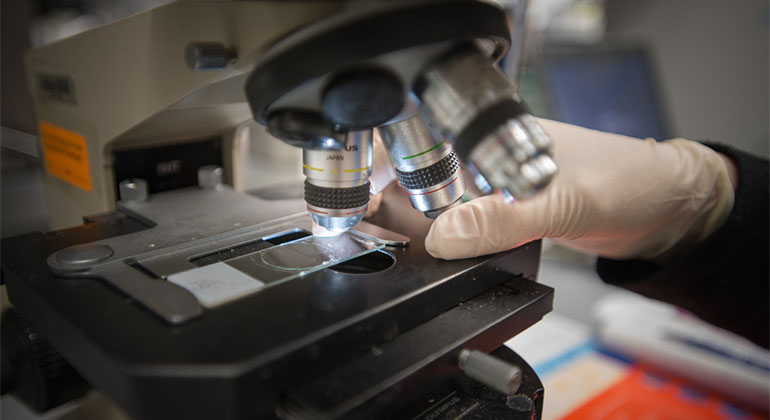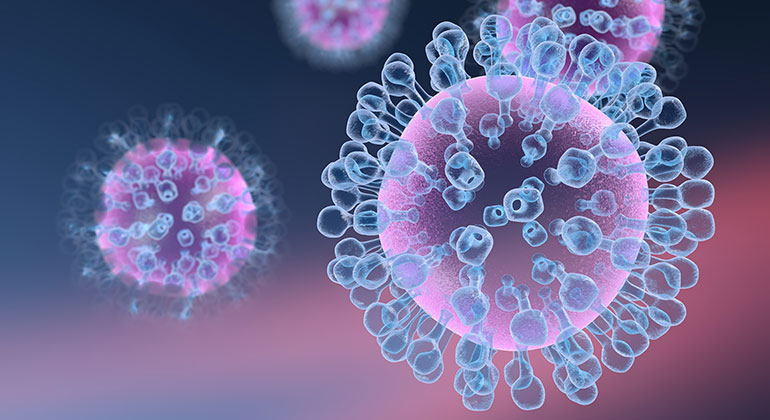Researchers Discover How Flu Viruses — From the Least Pathogenic to the Deadliest Strains — Hijack Human Cell Machinery to Reproduce
Much is known about flu viruses, but little is understood about how they reproduce inside human host cells, spreading infection. Now, a research team headed by investigators from the Icahn School of Medicine at Mount Sinai is the first to identify a mechanism by which influenza A, a family of pathogens that includes the most deadly strains of flu worldwide, hijacks cellular machinery to replicate.
The study findings, published online today in Cell, also identifies a link between congenital defects in that machinery — the RNA exosome — and the neurodegeneration that results in people who have that rare mutation.
It was by studying the cells of patients with an RNA exosome mutation, which were contributed by six collaborating medical centers, that the investigators were able to understand how influenza A hijacks the RNA exosome inside a cell’s nucleus for its own purposes.
“This study shows how we can discover genes linked to disease — in this case, neurodegeneration — by looking at the natural symbiosis between a host and a pathogen,” says the study’s senior investigator, Ivan Marazzi, PhD, an assistant professor in the Department of Microbiology at the Icahn School of Medicine at Mount Sinai.
Influenza A is responsible in part not only for seasonal flus but also pandemics such as H1N1 and other flus that cross from mammals (such as swine) or birds into humans.
“We are all a result of co-evolution with viruses, bacteria, and other microbes, but when this process is interrupted, which we call the broken symmetry hypothesis, disease can result,” Dr. Marazzi says.
The genes affected in these rare cases of neurodegeneration caused by a congenital RNA exosome mutation may offer future insight into more common brain disorders, such as Alzheimer’s and Parkinson’s diseases, he added. In the case of Influenza A, the loss of RNA exosome activity severely compromises viral infectivity, but also manifests in human neurodegeneration suggesting that viruses target essential proteins implicated in rare disease in order to ensure continual adaptation.
Influenza A is an RNA virus, meaning that it reproduces itself inside the nucleus. Most viruses replicate in a cell’s cytoplasm, outside the nucleus.
The researchers found that once inside the nucleus, influenza A hijacks the RNA exosome, an essential protein complex that degrades RNA as a way to regulate gene expression. The flu pathogen needs extra RNA to start the replication process so it steals these molecules from the hijacked exosome, Dr. Marazzi says.
“Viruses have a very intelligent way of not messing too much with our own biology,” he says. “It makes use of our by-products, so rather than allowing the exosome to chew up and degrade excess RNA, it tags the exosome and steals the RNA it needs before it is destroyed.
“Without an RNA exosome, a virus cannot grow, so the agreement between the virus and host is that it is ok for the virus to use some of the host RNA because the host has other ways to suppress the virus that is replicated,” says the study’s lead author, Alex Rialdi, MPH, a graduate assistant in Dr. Marazzi’s laboratory.
Co-authors include investigators from the University of California-San Francisco, Columbia University, Regeneron Pharmaceuticals and Regeneron Genetics Center, Burnham Institute for Medical Research, and the University of California-Los Angeles.
The study was supported by NIH grants 2RO1AI099195 and DP2 2OD008651 (U.B.), and partially supported by HHSN272201400008C - Center for Research on Influenza Pathogenesis (CRIP) a NIAID-funded Center of Excellence for Influenza Research and Surveillance (A.G.S, H.v.B., R.A., and I.M.). Other support includes the Department of Defense W911NF-14-1-0353 (to I.M.) NIH grant 1R56AI114770-01A1 (to I. M.), NIH grant 1R01AN3663134 (I.M. and H.v.B), and NIH grant U19AI106754 FLUOMICS (I.M., R.A., S.C., N.K., A.G.S.).
About the Mount Sinai Health System
Mount Sinai Health System is one of the largest academic medical systems in the New York metro area, employing 48,000 people across its hospitals and more than 400 outpatient practices, as well as more than 600 research and clinical labs, a school of nursing, and a leading school of medicine and graduate education. Mount Sinai advances health for all people, everywhere, by taking on the most complex health care challenges of our time—discovering and applying new scientific learning and knowledge; developing safer, more effective treatments; educating the next generation of medical leaders and innovators; and supporting local communities by delivering high-quality care to all who need it.
Through the integration of its hospitals, labs, and schools, Mount Sinai offers comprehensive health care solutions from birth through geriatrics, leveraging innovative approaches such as artificial intelligence and informatics while keeping patients’ medical and emotional needs at the center of all treatment. The Health System includes approximately 9,000 primary and specialty care physicians and 11 free-standing joint-venture centers throughout the five boroughs of New York City, Westchester, Long Island, and Florida. Hospitals within the System are consistently ranked by Newsweek’s® “The World’s Best Smart Hospitals, Best in State Hospitals, World Best Hospitals and Best Specialty Hospitals” and by U.S. News & World Report's® “Best Hospitals” and “Best Children’s Hospitals.” The Mount Sinai Hospital is on the U.S. News & World Report® “Best Hospitals” Honor Roll for 2024-2025.
For more information, visit https://www.mountsinai.org or find Mount Sinai on Facebook, Twitter and YouTube.

Mount Sinai Researchers Develop Method to Identify Dormant Cells That Carry HIV
Mar 13, 2025 View All Press Releases
Mount Sinai Awarded $3.4 Million to Study Prostate Cancer in People With HIV
Sep 12, 2023 View All Press Releases

